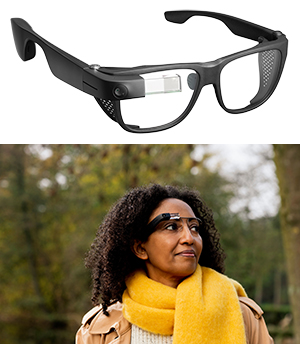Discover Advanced Assistive Tools for People With Visual Disabilities
The landscape of assistive technology for people with visual problems is progressing rapidly, offering a variety of ingenious tools that enhance freedom and engagement. From wise glasses that effortlessly combine visual input with auditory advice to innovative navigation applications that redefine spatial recognition, these devices are reshaping opportunities.
Smart Glasses Innovations
Smart glasses stand for a considerable development in assistive technology for individuals with aesthetic impairments. Outfitted with electronic cameras and sensors, smart glasses can record real-time visual details, which is then refined and communicated to the customer with audio responses or haptic sensations.
In addition, innovations in artificial intelligence have actually even more enhanced the abilities of clever glasses. Artificial intelligence formulas can identify faces, read message, and determine things, making them vital devices for everyday jobs. Customers can receive auditory signs that provide context regarding their environment, promoting freedom and self-confidence.
Additionally, the ergonomic style and light-weight nature of numerous wise glasses make them ideal for prolonged use, making certain comfort while boosting performance. As these devices remain to develop, they hold the prospective to change the way people with visual disabilities experience their everyday lives, bridging the gap in between ease of access and modern technology. The ongoing research study and growth in this area promise to increase the opportunities for smart glasses, making them a vital component of modern assistive devices.
Navigation Apps and Tools
Various navigating applications and devices have actually arised as crucial sources for people with aesthetic impairments, significantly boosting their capacity to go across unfamiliar settings. These innovations take advantage of GPS performance, audio hints, and real-time data to offer individuals with exact navigation assistance.
One prominent instance is the Aira application, which attaches customers to qualified representatives who can give aesthetic summaries of surroundings and navigation advice through a live video feed. This service improves the user's spatial understanding and confidence while navigating. One more remarkable tool is Seeing Eye GPS, which supplies voice-guided navigating and sights, allowing users to gain access to crucial information concerning their environments.

As modern technology continues to advancement, the growth of a lot more innovative navigating devices guarantees to more empower people with aesthetic impairments, assisting in seamless mobility and integration into diverse environments. Such innovations are important in advertising a much more comprehensive culture.
Braille Innovation Advancements
In recent times, improvements in Braille modern technology have actually significantly changed exactly how people with aesthetic impairments accessibility information and engage with the world around them. The development of portable Braille displays has transformed analysis by permitting customers to attach wirelessly to computer systems, tablets, and eye exam od mobile phones. These gadgets transform message right into Braille in real-time, allowing seamless communication with digital material.
Additionally, innovative Braille printers have emerged, improving the production of responsive products. Modern embossers are quicker and a lot more effective, permitting the fast development of Braille documents and educational materials. This efficiency lowers the time and price related to creating Braille resources, making them extra easily accessible to organizations and schools.
Furthermore, the assimilation of Braille with other technologies, such as expert system and artificial intelligence, has opened up new methods for individualized knowing experiences. Voice recognition and synthesis modern technologies can complement Braille, giving a comprehensive method to details dissemination.
As the need for inclusive education and work environment settings grows, these technical innovations play an essential duty in equipping people with visual disabilities, ensuring they have equal accessibility to info and opportunities in numerous elements of life.
Wearable Tools for Independence
An expanding selection of optometrist career wearable gadgets is improving freedom for individuals with aesthetic impairments, supplying cutting-edge solutions that boost navigation and day-to-day living. Braille displays and notetakers. These devices make use of sophisticated modern technologies to supply real-time responses and assistance, promoting autonomy in different settings

Wearable technology likewise consists of smartwatches that can be programmed with access features, allowing customers to get notifications, track their places, or perhaps call for aid with the touch of a button. Some gadgets include artificial intelligence to evaluate the setting, offering sound summaries of neighboring things or people.
Voice-Activated Assistive Solutions
Leveraging voice-activated assistive services has actually changed the click here for more info landscape of assistance for people with visual disabilities, giving hands-free interaction and accessibility to a selection of jobs. These innovations make use of all-natural language processing and fabricated intelligence to make it possible for customers to carry out everyday tasks through easy voice commands.

Additionally, recent developments in voice recognition accuracy have improved the user experience substantially, suiting varied accents and speech patterns. This inclusivity guarantees that even more individuals can take advantage of these innovations, promoting a higher feeling of autonomy.
Verdict
In verdict, the development of innovative assistive devices substantially improves the self-reliance and lifestyle for people with visual disabilities. Developments such as wise glasses, navigation applications, Braille modern technology, wearable tools, and voice-activated solutions jointly cultivate a more inclusive environment. These technologies empower customers to navigate their surroundings with self-confidence and involve more fully with the world, inevitably advertising higher ease of access and equal opportunities for people encountering aesthetic obstacles.
The landscape of assistive innovation for individuals with aesthetic disabilities is developing quickly, presenting a range of cutting-edge devices that enhance autonomy and engagement.Smart glasses represent a significant innovation in assistive innovation for people with visual impairments. As these devices proceed to progress, they hold the possible to reinvent the method people with aesthetic impairments experience their day-to-day lives, bridging the space between access and modern technology.In current years, developments in Braille technology have dramatically changed how people with visual problems gain access to information and engage with the globe around them. These technologies empower customers to navigate their environments with confidence and involve even more totally with the world, inevitably advertising greater accessibility and equal chances for individuals dealing with aesthetic challenges.